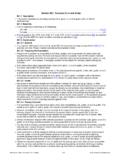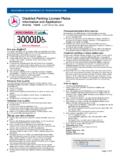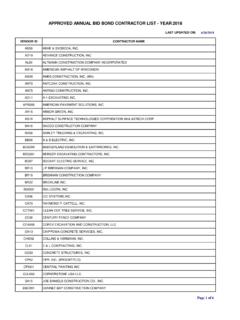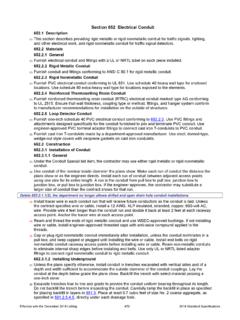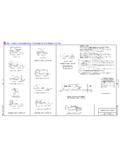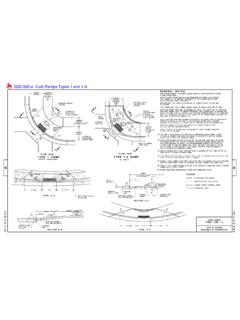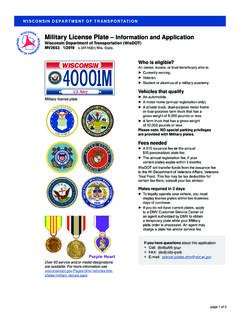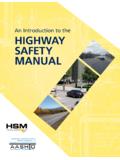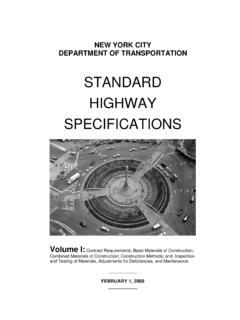Transcription of Facilities Development Manual Wisconsin Department of ...
1 Page 1 Facilities Development Manual Wisconsin Department of Transportation Chapter 11 Design section 15 Cross- section Elements for Rural Highways and Freeways FDM 11-15-1 Dimensions and Design Classes March 16, 2018 Design criteria for various rural highway systems are given in this procedure.
2 Attachment , and are for rural state trunk highways classified as arterials, collectors and locals respectively. Attachment provide separate design criteria for highways in level terrain and rolling terrain. Level terrain is the most prominent topography in Wisconsin and as such most projects will be designed using the level terrain criteria. Attachment applies to new construction and reconstruction of town roads. Attachment , and are for rural county trunk highways classified as arterials, collectors and locals respectively. Desirable and Minimum Design Criteria Use desirable design standards by default.
3 Consider using less-than-desirable standards only when they are justified based on a careful analysis of environmental impacts, social impacts, and crash history. Justification for the use of less-than-desirable values shall be documented and approved in the project s Design Study Report. Consider using less-than-minimum design criteria only for unique situations where upgrading the roadway to even minimum design criteria will cause excessive impacts to community or environmentally sensitive areas, and where it can be proven from the existing crash history that safety problems do not exist.
4 Consider using greater-than-desirable design criteria only in those rare cases where extraordinary measures must be taken to address a serious roadway problem or to accommodate a very strong community value. Justification for using greater-than-desirable design criteria shall be documented and approved in the project s Design Study Report. The use of less-than-minimum design criteria for controlling criteria requires an approved Exceptions To Standards. See FDM 11-1-2 for information on preparing Exception to Standards Reports, and FDM 11-1-4 for information on Programmatic Exception to Standards (for 3R projects only).
5 The use of less-than-minimum design criteria for non-controlling criteria shall be justified, documented and approved in the Design Study Report. This documentation shall include a description of the impacts that are being avoided or reduced and a description of the crash history and other analyses completed to address safety concerns. FDM desirable design criteria values fall in the middle to upper range of the AASHTO design criteria values. AASHTO guidance strongly recommends that middle to upper range values be used in most cases, and that the minimum design criteria values only be used under special circumstances.
6 The reason that the desirable (or middle to upper design criteria) values are to be used in most cases is because of the added safety and operational benefits that they provide. Some of the benefits of wider lanes, shoulders and clear zones are: - Increased safety and comfort for the driver. - Decreased collision rates with increased lane, shoulder and clear zone widths as shown in studies - Increased capacity of the highway - Increased mobility on higher speed highways (freeways, expressways, higher order arterials) by increasing driver comfort when traveling at higher speeds - Increased room for driver to recover control of their vehicle and return to the roadway or at least achieve significant decelerations before striking a fixed object - Increased room for the lateral placement of vehicles as speed, volume and percentage of heavy, wider vehicles increases - Increased room to accommodate vehicle off-tracking along horizontal curves - Increased room for bicycle and pedestrian accommodations (See FDM 11-46-15)
7 - Improvements for drainage, disabled vehicles, collision avoidance maneuvers, and structural support of the traveled way Railroad Crossings Avoid designing projects to start or end at railroad grade crossings. Either extend lane width, shoulder width, or cross section changes through the grade crossing, or stop the changes well short of the crossing. See FDM 17-40-1. Cross Slope The normal cross slope of all pavement types is 2%. See FDM 11-40-1 for cross slope criteria for 3R projects. FDM 11-15 Cross- section Elements for Rural Highways and Freeways Page 2 Shoulders Shoulders must have adequate strength and stability to support
8 Occasional vehicle tire loads under all weather conditions without rutting or other surface variations. On tangent sections and crown runoff sections, shoulders slope 4% downward from the adjacent pavement edge. In super-elevated sections the shoulder slope will be a continuation of the pavement slope on the high side and 4% downward on the low side, except when the super-elevation rate exceeds 4%, in which case the low side shoulder slope shall equal the rate of super-elevation. However, when the shoulders of two lane highways are paved as an integral part of the travel lanes - and the paved portion is 6 feet or less in width - the paved shoulder slope shall be the same as the cross slope of the travel lanes.
9 The remaining unpaved portion of the shoulder is sloped 4%, except as previously noted for super-elevated sections. Width requirements for paved shoulders are shown on Attachment Shoulder Paving Policy 1. When resurfacing, restoring, or rehabilitating existing roadways; a. The shoulder next to designated driving lanes shall be paved on State Trunk Highways (STH's) functionally classified as arterials, regardless of traffic volume in accordance with Attachment of this procedure. b. The shoulder next to designated driving lanes shall be paved 3 foot on County Trunk Highways (CTHs) functionally classified as arterials, regardless of traffic volume.
10 C. Shoulders on STH's classified as collectors or locals and having a current AADT in excess of 750 vehicles shall be paved in accordance with Attachment of this procedure. d. CTHs functionally classified as collectors or locals, and other local highways may have paved shoulders at the discrection of the local officials. 2. On pavement replacement, reconstruction, and new construction projects the shoulder paving is described below. a. STH s with asphalt roadways and the Design Classification shows a total finished shoulder width of 6 feet or more requires a paved shoulder in accordance with Attachment of this procedure.
